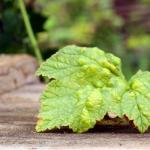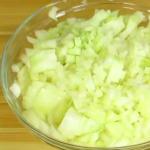
Causes of spots on the tops and tubers of potatoes
The appearance of spots on the tops of potatoes or on tubers is always a sign of a disease. If you do not pay attention to them in time, you can lose a significant part of the crop. Spots do not always indicate infection with a fungal, bacterial or viral infection: often such symptoms are accompanied by non-communicable diseases.
Signs of noncommunicable diseases
Potato non-infectious diseases occur due to violation of the proportions of fertilizer application, improper storage or inaccurate transportation of tubers. When symptoms of these diseases appear, it is necessary to revise the feeding schedule, change the method of harvesting (for example, dig potatoes not with a shovel, but with a pitchfork), and transport root crops more carefully.
The treatment period helps to significantly reduce the incidence of harvested tubers: for 7-14 days, the dug out potatoes should lie in a shaded but ventilated room. Then the peel of the tubers will harden, and transportation will not cause significant damage.
Melanosis (gray spotting) of tubers
The color of melanosis spots (Fig. 1) varies from light gray to gray-violet. Outwardly, the tuber looks healthy, but when cleaning inside, darkened areas with blurry borders are found. If such a potato is boiled, the dark areas will turn black. Tubers of starchy varieties are especially susceptible to gray spotting.
 Fig.1. Melanosis (gray spotting)
Fig.1. Melanosis (gray spotting) Melanotic spots, outwardly resembling bruises, often occur in places where tubers are bruised.
Other causes of gray spotting:
- excess nitrogen or lack of potash fertilizers;
- too early harvesting of potatoes;
- long stay of tubers in highly heated soil;
- oxygen starvation caused by storing potatoes at low temperatures (about 0 ° C) and insufficient ventilation;
- storage of tubers at high temperature (from +8 to +12 °C) for 70–90 days.
The incidence of melanosis is reduced if 100 g of soil on a potato bed contains 15–20 mg of potassium. So that potatoes prone to melanosis do not darken during cooking, a little (on the tip of a knife) citric acid is added to the water.
Rust (glandular spotting) of tubers
Red-brown spots appear inside apparently healthy tubers (Fig. 2): sometimes dotted, sometimes ring-shaped. The disease manifests itself after 6–8 weeks of storage. The tubers deteriorate very slowly, even by spring they do not massively rot.
 Fig.2. Rust (glandular spotting) of tubers
Fig.2. Rust (glandular spotting) of tubers The cause of the disease is an excess of iron with a lack of phosphorus and potassium in the soil. The best prevention is the application of organic fertilizers. When using mineral dressings, potatoes must be watered in a timely manner, otherwise the plants do not absorb the microelements contained in the soil.
Fungal infections
To prevent fungal diseases, you must strictly adhere to the rules of crop rotation, do not plant other plants of the nightshade family next to potatoes. In very small areas, nightshades are separated by at least one bed of corn or a “green curtain” of curly legumes: beans, peas. Rye roots disinfect the soil well. This cereal is sown in autumn, as green manure. In the spring, the site is dug up.
So that the tubers intended for planting do not become infected from potatoes left for food purposes, the seed material is stored separately and sorted out several times during the winter. Planting potatoes are much less susceptible to diseases if they are planted in autumn for 7-10 days.
Before planting, the tubers are pickled with a solution of copper sulphate, Bordeaux mixture, Maxim or Quadris fungicides. Of the biological products, Gamair and Alirin-B have a strong fungicidal effect.
During the growing season, plants are also sprayed with fungicides. Whey has good fungicidal properties, but it must be diluted with water in a ratio of 1: 1, otherwise there is a high risk of burning the leaves.
If there have been cases of fungal diseases on the site, it is recommended to mow the tops 2 weeks before harvesting and burn them. Tubers from under diseased bushes should not be left for seeds, and it is better to burn rotten potatoes (especially those infected with late blight).
late blight
With late blight, brown spots on potato leaves have an irregular shape, the boundaries are blurred (Fig. 3). On the reverse side of the sheet, a light “fluff” of a growing mycelium is visible. In dry weather, the disease develops slowly, and in cool and humid weather it develops rapidly.
 Fig.3. Late blight in the initial stage
Fig.3. Late blight in the initial stage The browned parts of the leaves dry out, becoming brittle. The stems are covered with brown stripes of rotting tissue. The pathogen from the leaves penetrates the soil, where it infects the tubers (Fig. 4), which begin to rot. After that, the entire bush must be burned, otherwise an epidemic will begin.
 Fig.4. Late blight in the final stage
Fig.4. Late blight in the final stage In addition to the usual chemical (Bravo, Shirlana) and biofungicides, in order to stop the epidemic, potato plantations are sprayed with copper preparations: copper sulfate, Bordeaux mixture, Zoltozan, Tsineb, Kuprikol.
Alternariosis
The disease, which is otherwise called early late blight, begins with the fact that the leaves are covered with small specks of drying tissues. Gradually, the dots increase, turn into spots of a concentric shape (with a darker middle) (Fig. 5).
 Fig.5. Alternariosis
Fig.5. Alternariosis In cool, damp weather, the stems quickly rot and break. In the final stage, the disease affects the tubers. Small black spots on potatoes at first only slightly depressed, with a velvety surface, gradually increase. If such a tuber is stored, it will rot itself and infect neighboring potatoes.
powdery mildew
Whitish spots appear on the leaves, as if sprinkled with flour (Fig. 6). Over time, the area of the affected areas increases, the leaves turn gray and die prematurely. The process of photosynthesis stops, because of which you can lose up to 40% of the crop.
 Fig.6. powdery mildew
Fig.6. powdery mildew Andean phomosis
Andean phomosis begins with the appearance of tiny dark spots on the leaves. Gradually, the spots increase, a premature “autumn” begins for the leaf: yellow, brown-red and brown areas appear on the plate (Fig. 7). The disease can destroy 20-80% of the crop.
 Fig. 7. Andean phomosis
Fig. 7. Andean phomosis fomoz
Phomosis (button rot, gangrene) most often affects potato bushes during flowering. Lines appear on the sprouts, turning into deep strips of rotting tissue, due to which the stems break and the plants die.
In tubers, the disease develops slowly, and it is difficult to identify diseased potatoes at harvest. Phomosis appears 1–4 months after storage. Spots on potatoes (Fig. 8) have clearly defined edges that separate the diseased tissue from the healthy one, gradually dents with a hard surface form on the surface.
 Fig.8. fomoz
Fig.8. fomoz Bacterial diseases
In case of bacterial diseases, it is important to observe crop rotation, disinfect the soil with winter rye crops. Before planting, potatoes are treated with Maxim. If a lot of tubers have rotted during the winter (sick potatoes are not always noticeable when harvesting), the plot in the spring, before planting, is shed with a solution of the Quadris preparation, prepared according to the instructions.
ring rot
If a ring of orange-brown, foul-smelling tissue is visible on a section of an apparently healthy tuber, then the potato is affected by ring rot (Fig. 9). When squeezed, a yellow mass begins to stand out from the spot on the potato.
 Fig.9. ring rot
Fig.9. ring rot Rotting areas expand slowly, but in the later stages of the disease, pits form on the surface of the potato. If a diseased tuber is planted, then the bacteria from it will penetrate into the vessels of the sprouts and clog them. An infected bush will not give a good harvest.
brown rot
Brown rot (Fig. 10) affects mainly tubers. Due to the fact that they rot, the whole bush dries up. In the first year, the disease may not manifest itself. But infected planting material infects all tubers.
 Fig.10. brown rot
Fig.10. brown rot The disease actively develops during flowering. First, crescent-shaped spots form inside the tubers. Then the diameter of the brown spot on the potato increases, and by autumn all the flesh darkens.
Virus diseases of potatoes
The most famous of viral diseases are a variety of mosaics: striped (Fig. 11), speckled, folded, rustling. All of them are characterized by the fact that the tops are covered with specks and stripes of dead tissue, dry out prematurely.
 Fig.11. striped mosaic
Fig.11. striped mosaic If you do not attach importance to this, in a few years the potato will degenerate. The virus persists in the tubers, and year by year the yield is getting smaller. When mosaic cases appear on the site, it is necessary to completely change the variety. For prevention, it is necessary to follow the rules of crop rotation and in the fall, after harvesting potatoes, sow the plot with rye.
















